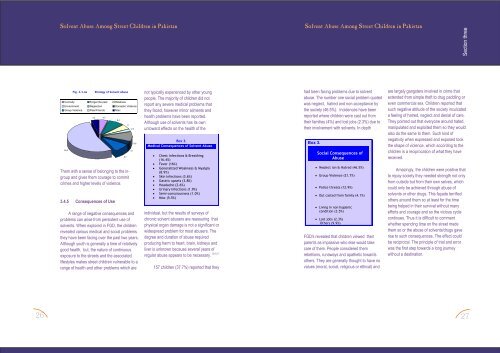solvent-abuse-pakistan
solvent-abuse-pakistan
solvent-abuse-pakistan
You also want an ePaper? Increase the reach of your titles
YUMPU automatically turns print PDFs into web optimized ePapers that Google loves.
Section three<br />
Fig. 3.3.4a<br />
Etiology of Solvent Abuse<br />
Curiosity Forget the past Relatives<br />
Enviornment Neglection Domestic Voilence<br />
Group Violence Peer/Friends Misc<br />
53.6<br />
Them with a sense of belonging to the ingroup<br />
and gives them courage to commit<br />
crimes and higher levels of violence.<br />
3.4.5 Consequences of Use<br />
4.3<br />
A range of negative consequences and<br />
problems can arise from persistent use of<br />
<strong>solvent</strong>s. When explored in FGD, the children<br />
revealed various medical and social problems<br />
they have been facing over the past two years.<br />
Although youth is generally a time of relatively<br />
good health, but, the nature of continuous<br />
exposure to the streets and the associated<br />
lifestyles makes street children vulnerable to a<br />
range of health and other problems which are<br />
4.3<br />
8.4<br />
8.7<br />
5<br />
2.6<br />
3.1<br />
9.9<br />
not typically experienced by other young<br />
people. The majority of children did not<br />
report any severe medical problems that<br />
they faced, however minor ailments and<br />
health problems have been reported.<br />
Although use of <strong>solvent</strong>s has its own<br />
untoward effects on the health of the<br />
Box 3.<br />
Medical Consequences of Solvent Abuse<br />
Chest Infections & Breathing<br />
(16.4%)<br />
Fever (16%)<br />
Generalized Weakness & Myalgia<br />
(8.9%)<br />
Skin Infections (3.6%)<br />
Gastric upsets (3.8%)<br />
Headache (2.6%)<br />
Urinary Infections (1.9%)<br />
Semi-consciousness (1.0%)<br />
Misc (5.5%)<br />
individual, but the results of surveys of<br />
chronic <strong>solvent</strong> <strong>abuse</strong>rs are reassuring that<br />
physical organ damage is not a significant or<br />
widespread problem for most <strong>abuse</strong>rs. The<br />
degree and duration of <strong>abuse</strong> required<br />
producing harm to heart, brain, kidneys and<br />
liver is unknown because several years of<br />
35,43,17<br />
regular <strong>abuse</strong> appears to be necessary.<br />
157 children (37.7%) reported that they<br />
had been facing problems due to <strong>solvent</strong><br />
<strong>abuse</strong>. The number one social problem quoted<br />
was neglect, hatred and non-acceptance by<br />
the society (46.5%). Incidences have been<br />
reported where children were cast out from<br />
their families (4%) and lost jobs (2.3%) due to<br />
their involvement with <strong>solvent</strong>s. In depth<br />
Box 3.<br />
Social Consequences of<br />
Abuse<br />
Neglect ion & Hatred (46.5%)<br />
Group Violence (21.7%)<br />
Police threats (12.9%)<br />
Out casted from family (4.1%)<br />
Living in non hygienic<br />
condition (3.5%)<br />
Lost jobs (2.3%)<br />
Others (9.9%)<br />
FGD's revealed that children viewed their<br />
parents as impassive who else would take<br />
care of them. People considered them<br />
rebellions, runaways and apathetic towards<br />
others. They are generally thought to have no<br />
values (moral, social, religious or ethical) and<br />
are largely gangsters involved in crime that<br />
extended from simple theft to drug paddling or<br />
even commercial sex. Children reported that<br />
such negative attitude of the society inculcated<br />
a feeling of hatred, neglect and denial of care.<br />
They pointed out that everyone around hated,<br />
manipulated and exploited them so they would<br />
also do the same to them. Such kind of<br />
negativity when expressed and exposed took<br />
the shape of violence, which according to the<br />
children is a reciprocation of what they have<br />
received.<br />
Amazingly, the children were positive that<br />
to repay society they needed strength not only<br />
from outside but from their own selves, which<br />
could only be achieved through <strong>abuse</strong> of<br />
<strong>solvent</strong>s or other drugs. This façade terrified<br />
others around them so at least for the time<br />
being helped in their survival without many<br />
efforts and courage and so the vicious cycle<br />
continues. Thus it is difficult to comment<br />
whether spending time on the street made<br />
them so or the <strong>abuse</strong> of <strong>solvent</strong>s/drugs gave<br />
rise to such consequences. The effect could<br />
be reciprocal. The principle of trial and error<br />
was the first step towards a long journey<br />
without a destination.<br />
26<br />
27


